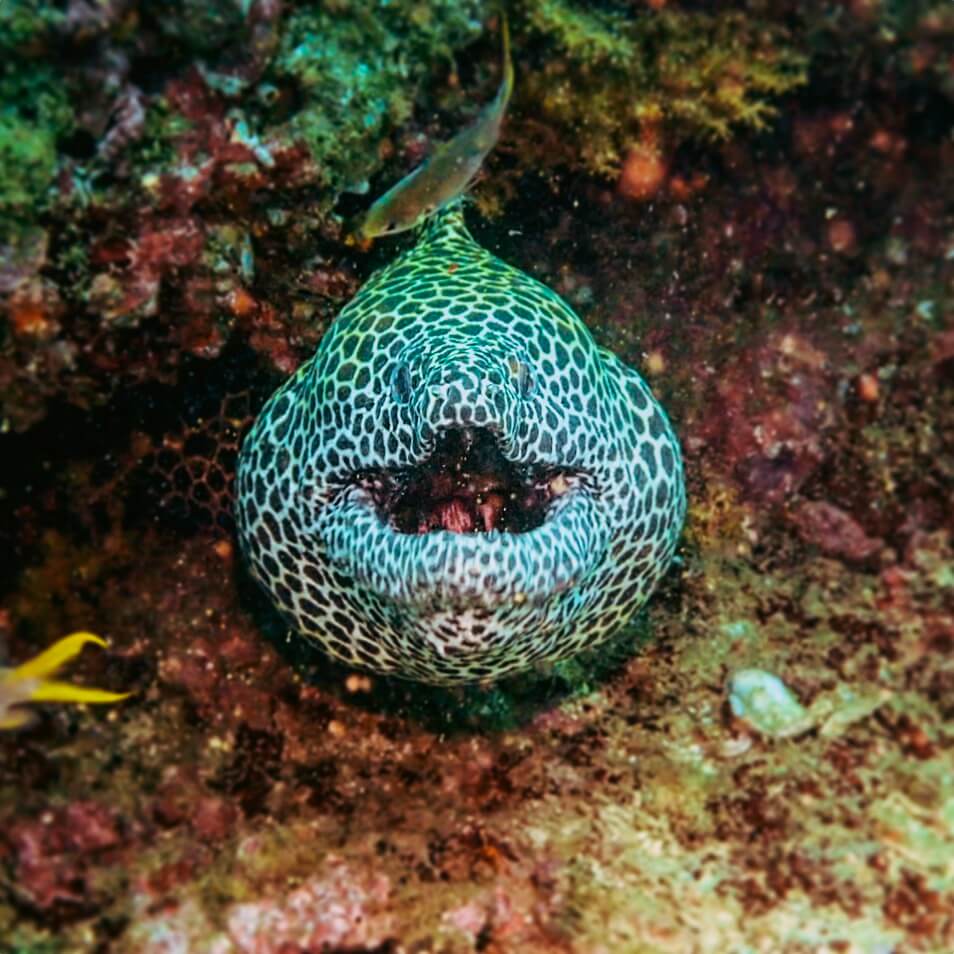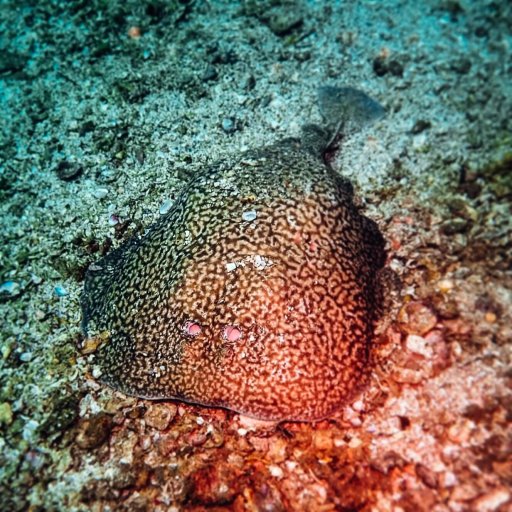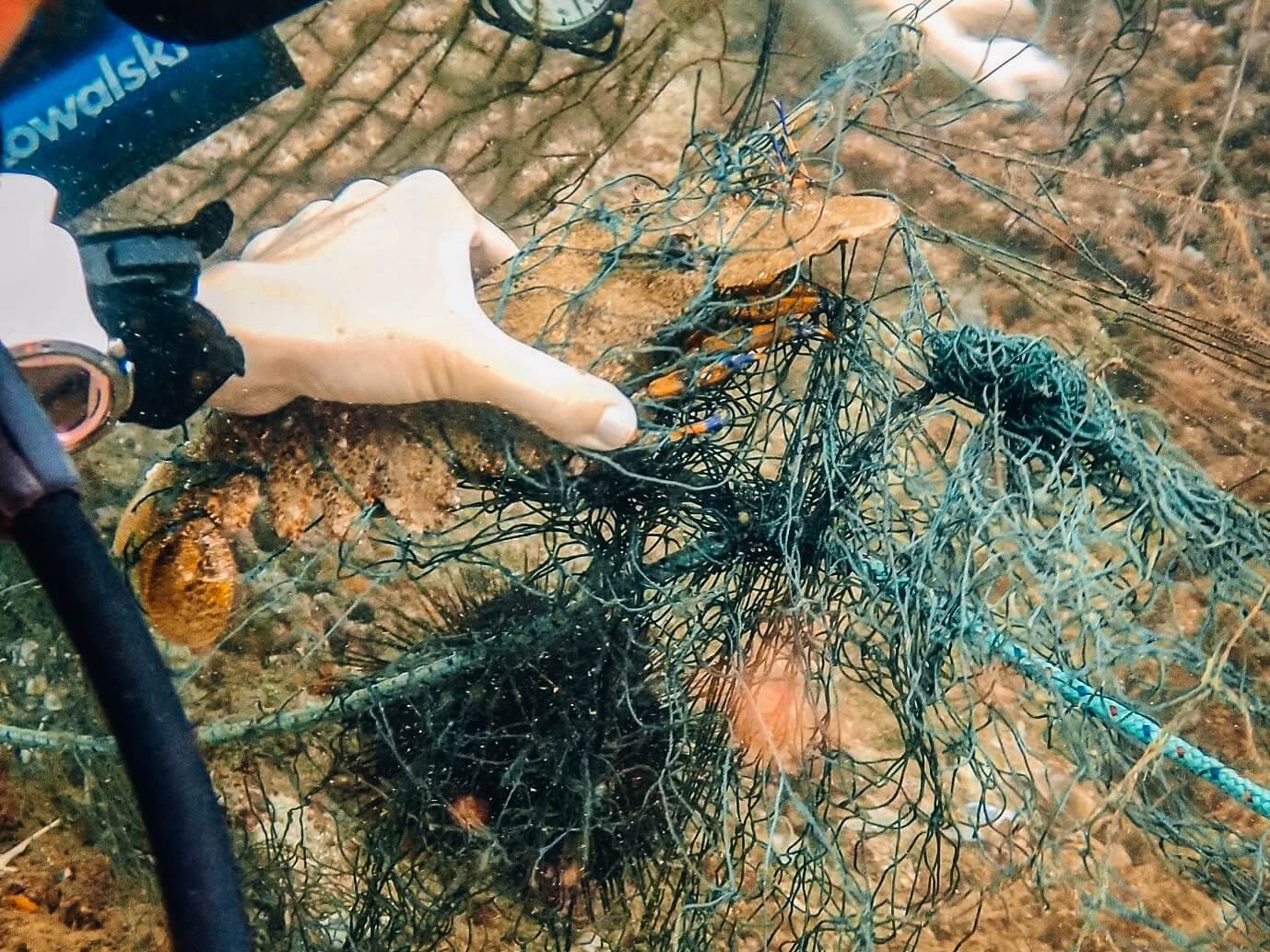Disclaimer: If you suffer from any amount of thalassophobia (fear of the sea) please skip this one. The sea is a wonderful, beautiful place, and my posts usually aim to educate on the safety of being surrounded by even the most feared sea creatures. This post is for people who enjoy the spookier things in life.
One of the first things any new open water student learns in their scuba diving course is to never, ever touch anything underwater. This is both for your own safety, and the safety of the environment around you. Many species of corals and fish are covered in a layer of mucus that acts as an anti-bacterial shield. When we touch them, the natural oils on our skin remove that barrier and leave the sea-life prone to diseases and parasites. I used to dive in places where that was the only real concern, and had to just hope that divers would monitor their fin and hand placement with respect.
In Oman, if divers didn’t keep their hands to themselves, they were the ones left regretting it.
I’ll get to the dangerous stuff in a minute, but let’s start with the creepy.
Moray Eels
Eels are maybe the second most feared creature in the ocean after sharks, and like sharks, this is probably due largely in part to Hollywood. What kind of creatures were the villain sidekicks in The Little Mermaid? Or how about that scene from the classic, The Deep, where the eel attacked the diver? I assure you that last one was not an accurate depiction. Eels tend to be quite shy creatures, with terrible eyesight. Just don’t go poking your fingers at them, because they may think you are offering them a treat.
To further highlight the creepy factor of eels, let’s talk about that second jaw for a moment. That’s right, eels have not just the first jaw full of rows of needle-sharp teeth that you get to see, but a second jaw, called a pharyngeal jaw (click here to see some cool graphics). This jaw is hidden down in the eel’s throat. When an eel bites its pray, the primary jaw holds the food while the second jaw comes up from the abyss to drag the pray down to its doom, like some horrifying creature in an alien movie. Ready to close this window and go look at cute puppy pictures yet?
Oman was home to more different varieties of eels than anywhere I have ever been, so if eels are your thing, then Oman is the place to visit!
Honeycomb Moray
These bad boys are beautiful with their black and white honeycomb pattern covering their entire body. They can also grow to be a whopping 3 meters long. That’s right, that’s longer than the tallest person ever recorded was tall (who happened to be Robert Wadlow at 2.72 meters, or 8’ 11” tall). So regardless of being shy and mostly harmless, do you see how diving through murky, green water, and then suddenly coming face-to-face with one of these could give you a miniature heart attack?
Undulated Moray
Yellowmouth Moray
The yellowmouth moray is cleverly named because, as you might have already guessed, when it opens its mouth, it is bright yellow inside. What were you eating, Mr. Eel? Turmeric tea? Banana Laffy Taffy? Yellow snow cones? Nature has some interesting reasons to make various creatures the colors they are. Male birds tend to be colorful to attract females. Frogs tend to be brightly colored to warn predators that they are poisonous. But giving a neon yellow mouth to an otherwise dull, brown eel? I guess it’s so that if you’re a small fish, you know you’ve made a big mistake right before that pharyngeal jaw comes up for you.
Peppered Moray
Alright, I know I’m talking about creepy crawlies, but this little guy was actually one of my favorites in Oman. Isolated to the Western Indian Ocean, I had never seen him before. The reason I liked him so much was because I found his markings on his face to be hilarious. He looks like one of those ladies who shaves their eyebrows and then draws them on again, in that wonderful, permanently surprised arch that’s never quite even over both eyes. No offense if you are one of those ladies. I’m comparing my favorite eel to you, so I guess it’s kind of a compliment…
Electric Ray
Have you had enough of eels yet? Let’s move on to something else that newcomers to the ocean tend to get freaked out by: rays. Rays never had a bad rap until Steve Irwin went and got himself killed by one. Ouch, that came out harsh, but if you know rays, and you read about what actually happened, then you know that the ray was not to blame.
There are many different kinds of rays. Rays belonging to the stingray order (Myliobatiformes), have stingers on their tails for defense. That’s defense, not offense. They don’t just swim up to you and start stabbing. Normally, rays will just swim away if they feel threatened. Only when they have nowhere to go (like if you step on one) do they swing their tails up and sting whatever they come into contact with. Unfortunately for Steve Irwin, that just happened to be his heart. He and his cameraman were in chest-deep water looking for tiger sharks, so you can see how not being able to go up or down (because the water was shallow), not having much space to navigate around two grown men (the ray itself was reportedly 8 feet), and being in tiger shark infested waters (which hunt rays), would cause a poor ray to feel like he was about to be chum. Moral of the story: just give the stingray an escape route and everyone lives happily every after.
Manta rays are another family of ray (though they do oddly still belong to the stingray order), and to answer everyone’s favorite question when going on manta dives, no, they do not have stingers.
Oman introduced me to a third kind of ray that I had never known even existed before: the electric ray. These weirdos have their own order, Torpediniformes. Now usually when I try to look up new critters online to learn something about them, the only hits I get are scientific taxonomy and ecology facts that would put any sane person to sleep, and a harrowing amount of information on how to keep said critter in an aquarium. Thanks, I really wanted to know what size tank to get for my pet honeycomb moray once he reaches 3 meters long…
That was not the case for the electric ray though. No, there is a surprising wealth of fascinating lore about this odd creature! Check out these fun facts:
-
- The name comes from the latin torpere which means to be stiffened or paralyzed, which is exactly the effect it has on whatever comes into contact with it.
-
- They produce an electric discharge, which can range anywhere from 8 to 220 volts depending on the species (of which there are 69).
-
- Their electric shocks were used by the ancient Greeks to numb all sorts of pain, from childbirth to gout.
-
- Ever heard of narcotics? We have the ancient Greeks and their electric ray treatment to thank for those too. Narke was the Greeks’ name for the electric ray, and hence became the name for the shock treatment that numbed the senses (and later the drugs).
-
- Before electricity was discovered, the electric ray was considered a magical creature. Pre-modern natural histories considered it evidence of occult qualities existing in nature.
Scorpionfish
Scorpionfish are one of the most venomous fish in the ocean, and their abundance scared me to death in Oman. Not because I was afraid of coming into contact with one, but because there’s always that one diver who feels the need to put their hands on everything. You can only tell them so many times not to touch. Every time you turn around, there’s their hand on the nearest surface again. And I’m sorry, but if you’re dumb enough to touch everything, then you’re dumb enough to not pay any mind to what you are touching, and scorpionfish blend in beautifully with their surroundings.
Ok, so maybe I was really just waiting to laugh at the next touchy feely person for getting karma’d by a scorpionfish.
Flower Urchin
One day while diving, I noticed a variety of sea urchin that I was unfamiliar with. It was about the size of a large pin cushion, a pleasant shade of peachy orange, and upon close inspection, its spines opened up like little miniature calla lilies. Now I know the theme of this entire post has been “keep your hands to yourself underwater,” but this urchin reminded me of one in the Virgin Islands a while back. I had been diving there, and the dive guide handed me a sea urchin and instructed me to flip my hand over. The thing magically stuck to my hand like velcro. I’ve always wondered what kind it was. With each new urchin I meet, I can’t help but wonder if it would preform the same trick, but most sea urchins are covered in sharp spines, so of course I’m not about to go testing them all out.
I saw the little pink-orange calla lilies and thought they might act like little suction cups, so I went home and looked it up.
Thank goodness I’m not the kind of person who goes touching everything underwater, because as it turns out, the “flower urchin” just happens to be the most toxic species of urchin in the world. Yeah, each one of those pretty little “flowers” is actually a tiny claw that injects toxin.
Luckily there aren’t many recent records of people getting stung by these, but there is a terrifyingly descriptive story from a Japanese researcher who was stung by one back in 1930. Dr. Tsutomu Fujiwara scooped one up with his bare hand and recounts how 7 or 8 of the “pedicellariae” (flowery things) detached from the urchin and stuck to his fingers. He immediately felt a severe pain, similar to a jellyfish sting, and could actually feel the toxin being moved from the stung area, through his blood vessels, and to his heart.
After a while, I experienced a faint giddiness, difficulty of respiration, paralysis of the lips, tongue and eyelids, relaxation of muscles in the limbs, was hardly able to speak or control my facial expression, and felt almost as if I were going to die.
He continues that the pain began to diminish after 15 minutes, and disappeared after an hour, but the facial paralysis lasted for six whole hours. Yikes.
While these urchins may not use the little flowery appendages as suction cups, they do like to stick things to themselves. More often than not, they were seen with a nice little collection of pet rocks piled on top of themselves.
So there you have it, all the evidence you need that getting all touchy feely underwater is not a good idea. Next time we’ll get back to the bright side of the sea and I’ll show you all the new species of pretty, colorful fish I met. I’ve been promising that for quite a while now, haven’t I? The wait is almost over…



























